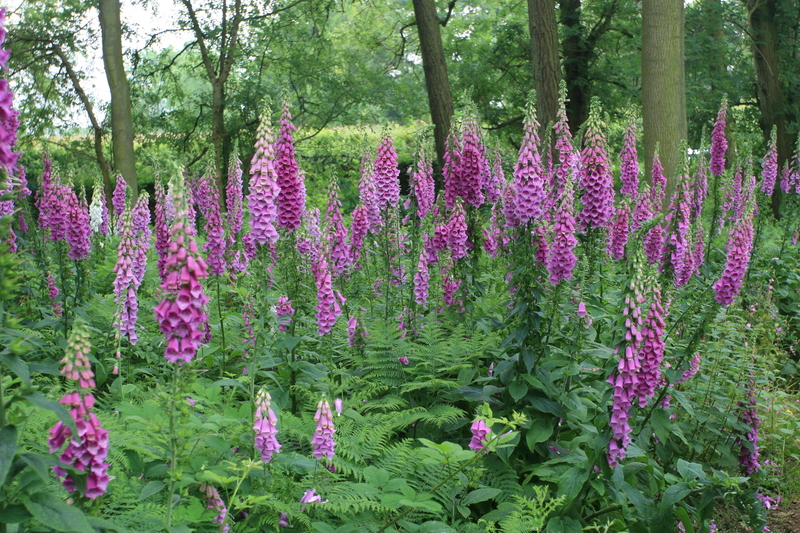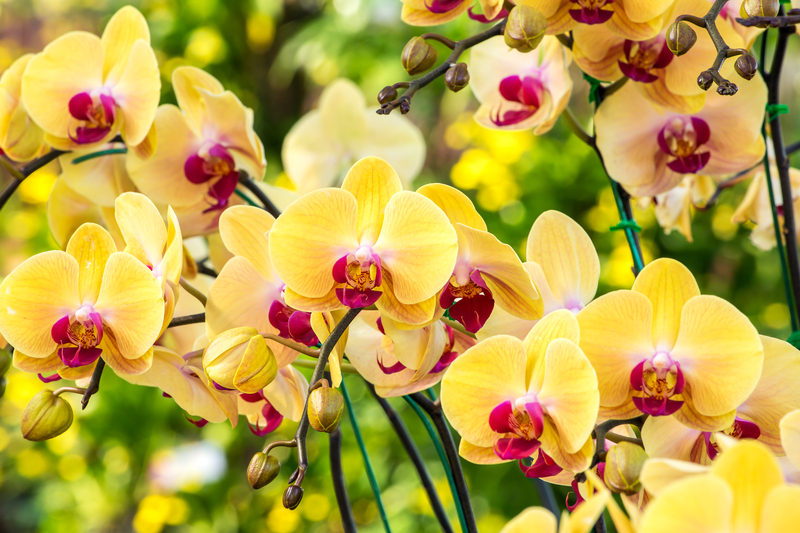Turn Wind Challenges into Garden Opportunities
Posted on 18/08/2025
Turn Wind Challenges into Garden Opportunities: Transforming Problematic Winds into Garden Success
Have you ever wondered how to turn relentless wind into a bonus instead of a hurdle in your garden? If so, you're not alone! Many gardeners see wind as an obstacle, plagued by broken stems, battered leaves, and lost moisture. But what if we told you that garden wind challenges can become unique garden opportunities? Read on to discover creative and practical ways to make wind work for your garden, rather than against it.
Understanding Wind: The Gardener's Unseen Ally
Before you can leverage wind as an asset, it's essential to understand its impact on the home garden. Wind influences temperature, moisture, pollination, and even the integrity of structures and plants.
- Moderate wind helps strengthen plant stems and promotes air circulation, minimizing fungal issues.
- Strong wind can cause excessive evaporation, plant stress, or physical damage.
- Consistent breezes may help naturally pollinate certain crops, especially those dependent on wind-pollination like corn and grasses.
Learning to manage and harness wind can mean the difference between a struggling landscape and a thriving, resilient haven.

Wind in the Garden: Challenge or Chance?
The challenges posed by wind are often viewed negatively. However, turning wind challenges into garden opportunities starts with changing mindset and approach. Here's how wind can become a catalyst for garden innovation:
- Pest Control: Windy conditions make it harder for pests like aphids and spider mites to settle on plants, naturally reducing infestations.
- Disease Prevention: Good air circulation dries foliage quickly, reducing fungal diseases like mildew and blight.
- Pollination: Wind can assist pollination for many crops, improving yields.
- Structural Creativity: Devising windbreaks and supports encourages creative landscape design and plant choices.
- Soil Improvement: Smart wind management helps prevent erosion and enhances soil structure.
Common Wind-Related Problems in Gardens
Identifying common wind issues is key to transforming them into positives:
- Desiccation: Excessive water loss from soil and leaves.
- Physical Damage: Broken stems, shredded leaves, and uprooted plants.
- Soil Erosion: Loss of valuable topsoil due to wind scour.
- Hindered Growth: Young or newly transplanted plants failing to thrive because of wind stress.
With awareness, you can design strategies that turn these disadvantages into wind-powered garden advantages.
Garden Design Solutions: Embracing the Wind
Windbreaks: Your Garden's First Line of Defense
A well-planned windbreak is the most effective way to mitigate harsh winds and optimize your microclimate. The goal is not to block wind entirely but to filter and diffuse it, creating a calmer zone for sensitive plants.
Types of windbreaks:- Living Windbreaks: Hedges, trees, and thick shrubs. Consider species like Thuja, Taxus, or fast-growing willows and poplars.
- Artificial Barriers: Fences made from wood, mesh, or slatted panels allow some air to pass through, reducing wind pressure.
- Mixed Plantings: Layered plant rows of varying heights for maximum wind disruption and biodiversity.
Tip: Position windbreaks perpendicular to the prevailing wind for best results.
Plant Selection: Choosing Wind-Resilient Plants
Certain plants naturally fare better in breezy conditions. Consider incorporating these wind-tolerant species into your garden:
- Grasses: Miscanthus, feather grass, and switchgrass elegantly sway and flex in strong breezes.
- Groundcovers: Creeping thyme, sedges, and low-growing junipers protect soil and reduce erosion.
- Wind-Resistant Shrubs: Hebe, elaeagnus, and escallonia offer shelter and structure.
- Salt- and Wind-Tolerant Trees: Pines, oaks, and hawthorns shine in exposed sites.
Mixing these robust plants throughout your landscape helps create a self-sustaining, attractive garden that can turn wind stress into garden strength.
Adaptive Planting Techniques
- Stagger Your Rows: Instead of straight rows, stagger plantings to slow wind speed and reduce channeling effects.
- Thicken the Edges: Plant denser groups around vulnerable zones--these absorb and slow gusts before they hit sensitive plants.
- Mulching and Groundcover: Apply thick organic mulch or robust groundcovers to protect soils from drying and erosion.
- Wind-Smart Supports: Use stakes, cages, or trellises to keep tall or floppy plants upright and protected.
Wind as a Vital Garden Tool
With the right perspective, gardeners can utilize the positive aspects of wind to benefit their landscapes.
Wind-Driven Cooling and Air Circulation
- Less Disease: Moving air reduces dampness and discourages fungal outbreaks on leaves.
- Temperature Regulation: During summer, wind helps cool both plants and garden structures.
Harnessing Wind Power for Sustainability
Go a step further and integrate wind-powered features:
- Small Wind Turbines: Install a garden wind turbine to generate electricity for lights, fountains, or irrigation systems.
- Wind Chimes and Spinners: Not only decorative, but these can also help deter pests and add musical ambiance.
With innovation, wind becomes a renewable resource, helping green your garden and your lifestyle.
Pollinator Support and Seed Dispersal
Some plants rely on wind for pollination (anemophily) and seed dispersal. By embracing wind:
- Cultivate Wind-Pollinated Crops: Corn, grasses, and hazels thrive in windy spots.
- Encourage Self-Sowing: Allow certain annuals and perennials to disperse seeds naturally, filling empty spots with minimal effort.
DIY Projects: Building Wind Solutions in Your Garden
How to Create an Effective Living Windbreak
- Assess Your Wind Patterns: Identify the direction and strength of prevailing winds with flags, wind socks, or by observing plant damage.
- Choose Diverse Species: Mix tall trees, mid-height shrubs, and low groundcovers for a resilient, layered barrier.
- Plan for Spacing: Space plants wide enough for airflow and growth but close enough to block gusts.
- Maintain Regularly: Prune to preserve density, replacing any weak links in your windbreak.
Building an Attractive Wind Filter Fence
- Select Permeable Materials: Slatted wood, lath panels, or woven willow lets some wind through but slows damaging gusts.
- Anchor Sturdily: Bury fence posts deep and cement in place for stability in high winds.
- Integrate with Plants: Train vines like clematis or honeysuckle up the fence for added beauty and protection.
Preventing Wind Erosion with Groundcovers
Bare soil is most vulnerable to wind erosion. Here's how to turn that into a garden advantage:
- Mulch generously with straw, bark chips, or compost.
- Plant fast-spreading groundcovers like creeping phlox, periwinkle, or sedum.
- Add temporary cover crops (clover, rye) between rotations to hold soil in place and boost fertility.
Creative Garden Opportunities Driven by Wind
Sensory and Visual Appeal
- Movement adds drama - Ornamental grasses, bamboo, and tall perennials create kinetic sculptures when animated by wind.
- Soundscaping - Wind rustling through leaves, grasses, or wind sculptures enhances the atmosphere with soothing sounds.
- Wildlife Habitat - Shelter provided by dense windbreaks supports birds, pollinators, and beneficial insects.
Creating Microclimates
Strategic planting and windbreak placement can create warmer, more protected microclimates for tender or exotic plants.
- Grow frost-sensitive crops like tomatoes or citrus in the lee of a hedge or fence.
- Extend the growing season by sheltering raised beds or early vegetable rows from chilling gusts.
Edible and Decorative Hedges
Use windbreaks to double as edible landscapes:
- Berry Bushes: Currants, gooseberries, and blueberries make attractive, bountiful wind filters.
- Herbs and Aromatics: Rosemary, lavender, and bay laurel stand up to breezes while delighting in well-aerated soils.
Outdoor Living Spaces
Create inviting, usable spaces shielded from wind:
- Garden Rooms: Partition your landscape with screens, tall beds, or dense plantings for sheltered seating or play areas.
- Dine or relax comfortably outdoors, even in breezy weather, when your design harnesses wind protection and privacy together.
Maintenance: Sustaining Your Wind-Tamed Garden
- Monitor mulch and soil levels to prevent bare spots susceptible to erosion.
- Stabilize supports and fences yearly, repairing any damage promptly.
- Prune windbreaks regularly to maintain density and encourage healthy growth.
Common Mistakes to Avoid When Managing Wind
- Solid, impermeable barriers can create damaging wind eddies--choose permeable solutions instead.
- Ignoring neighbors' landscapes can leave gaps in defense; coordinate with adjoining gardens if possible.
- Overcrowding windbreaks may backfire long-term; ensure plenty of space as plants mature.

Inspiring Case Studies: Wind-Wise Gardens in Action
- Coastal Wind Gardens: In exposed coastal regions, gardeners use layered beach grass, salt-tolerant pines, and natural dunes as windbreaks, supporting vibrant perennial borders and vegetable beds in their shelter.
- Urban Rooftop Retreats: Rooftop gardens with trellis screens, dwarf evergreens, and sturdy containers create shared community spaces, thriving despite constant wind exposure.
- Homestead Farms: Rows of hybrid poplars and willow hedges shield orchards and crops, demonstrating how thoughtful wind management translates into higher fruit yields and healthy livestock.
Conclusion: Embrace Wind for a Resilient, Beautiful Garden
Rather than fighting the elements, transform wind challenges into garden advantages by observing, planning, and innovating your landscape. From living windbreaks and strategic plant choices to using wind for power and pollination, a wind-savvy garden is both practical and enchanting.
By working with the wind, you'll create a more resilient, diverse, and beautiful garden--one that flourishes in any breeze.
Frequently Asked Questions: Turning Wind Challenges into Garden Opportunities
- Q: What's the best plant for a living windbreak?
A: Fast-growing, dense species like willow, privet, or Leyland cypress are top choices, though your region's climate and soil may suggest others. - Q: Can wind actually improve my vegetable yields?
A: In moderation, wind aids pollination for crops like corn--and good air flow prevents many diseases, improving overall productivity! - Q: How high should my windbreak be?
A: Windbreaks shelter an area up to ten times their height downwind. For a vegetable bed, 6-8 feet usually suffices. - Q: Should I replace all damaged plants?
A: Not always! Observe which species recover best, and prioritize these for future plantings. Experimentation is key.
Ready to turn wind challenges into garden opportunities? With creativity, empathy for your site, and ongoing learning, your outdoor space will thrive--no matter how the wind blows.

